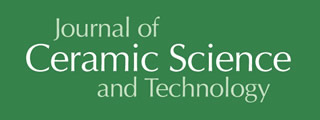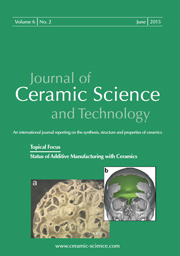Issues
 Journal of Ceramic Science and Technology 3/2017
Journal of Ceramic Science and Technology 3/2017
Vol. 8, No. 3
Topical Issue
Geopolymers
Guest Editors
Waltraud M. Kriven and Gregor J. G. Gluth
Preface
Dear readers,
Geopolymers have gained very much momentum in recent years, in science and in industry. These highly promising and versatile materials have been researched with a view to applications as diverse as fire-resistant/refractory materials, as precursors for ceramics, in waste stabilization/immobilization, and as novel building materials. The great interest in these materials is reflected, inter alia, by the installment of a session on geopolymers at the 92nd Annual Meeting of the Deutsche Keramische Gesellschaft (DKG; German Ceramic Society) in March 2017. Therefore this Special Issue is dedicated to disseminating some of the recent findings on these materials. In addition, it contains reviews by highly experienced researchers in the field, highlighting very different aspects such as fiber reinforcement and synchrotron-based characterization methods.
Partly due to the interest from very different fields, the term „geopolymer“ is used with two different meanings. Sometimes it is used in the sense to denote the ceramic-like materials produced by activation of metakaolin with alkali silicate solutions, and closely related materials. On the other hand, sometimes it is used in a much broader sense to refer to any material that is produced by alkali-activation of many different aluminosilicate precursors, such as fly ash and granulated blast furnace slag waste materials, often serving as a cementitious binder. The present issue focusses on applications and materials that may be classified as ceramic, but also contains a review on the use of alkali-activated materials as construction materials to make the reader familiar with this approach too. Additionally, some of the materials described in this issue may be regarded as being „on the borderline“ between ceramics and cements, which is something that can be said about many studies in the geopolymer field.
The editors are very grateful to each of the authors of the articles in the present issue, as all of them have contributed high quality research based on their extensive experience. In particular, the historial perpectives on the origins and developments of geopolymers and of alkali activated materials have been authoritatively documented in contributions, by Joseph Davidovits and Pavel Krivenko. Dr. Krivenko was the Ph.D. student of Viktor D. Glukhovsky who first introduced alkali activated cements in 1957. It is hoped that the readers of this issue will enjoy reading it as much as the editors enjoyed putting it together, and that the issue will stimulate more high quality studies of geopolymers, perhaps even from research groups that have not yet been active in this area.
Waltraud M. Kriven
(University of Illinois at Urbana-Champaign, Department of Materials Science and Engineering)
Gregor J. G. Gluth
(Bundesanstalt für Materialforschung und -prüfung (BAM), 7.4 Technology of Construction Materials)
Review Articles
A Review of Particle- and Fiber-Reinforced Metakaolin-Based Geopolymer Composites R.A. Sá Ribeiro, M.G. Sá Ribeiro, W.M. Kriven Vol. 8, No. 3, Pages 307-322 DOI: 10.4416/JCST2017-00048 Keywords: Geopolymer, metakaolin, particle composite, fiber composite, kaolin |
Why Alkaline Activation – 60 Years of the Theory and Practice of Alkali-Activated Materials P. Krivenko Vol. 8, No. 3, Pages 323-334 DOI: 10.4416/JCST2017-00042 Keywords: Alkaline activation, aluminosilicate, cement, concrete, durability, hydration products, terminology |
Geopolymers: Ceramic-Like Inorganic Polymers J. Davidovits Vol. 8, No. 3, Pages 335-350 DOI: 10.4416/JCST2017-00038 Keywords: Geopolymer, polymerization mechanism, applications, properties, molecular structure. |
Original Articles
Intumescent Geopolymer-Bound Coatings for Fire Protection of Steel M.-B. Watolla, G.J.G. Gluth, P. Sturm, W.D.A. Rickard, S. Krüger, B. Schartel Vol. 8, No. 3, Pages 351-364 DOI: 10.4416/JCST2017-00035 Keywords: Geopolymers, aluminosilicate inorganic polymers, intumescence, coatings, fire resistance, fire protection |
Control of Polycondensation Reaction Generated from Different Metakaolins and Alkaline Solutions A. Gharzouni, I. Sobrados, E. Joussein, S. Baklouti, S. Rossignol Vol. 8, No. 3, Pages 365-376 DOI: 10.4416/JCST2017-00040 Keywords: Metakaolin, alkaline solution, kinetics, oligomer formation, 27Al NMR |
High-Temperature Behaviour of Alkali-Activated Composites based on Fly Ash and Recycled Refractory Particles L. Carabba, S. Manzi, E. Rambaldi, G. Ridolfi, M.C. Bignozzi Vol. 8, No. 3, Pages 377-388 DOI: 10.4416/JCST2017-00047 Keywords: Alkali-activated composites, fly ash, refractory, thermal behaviour, heat exposure |
Influence of Elevated Temperatures on the Mechanical Behavior of Jute-Textile-Reinforced Geopolymers A.C. Constâncio Trindade, H.A. Alcamand, P.H. Ribeiro Borges, F. de Andrade Silva Vol. 8, No. 3, Pages 389-398 DOI: 10.4416/JCST2017-00045 Keywords: Geopolymers, composites, natural fibers, temperature |
Boronhydride-Geopolymer Composites C.H. Rüscher Vol. 8, No. 3, Pages 399-410 DOI: 10.4416/JCST2017-00051 Keywords: Hydrogen storage, AB-geopolymer, SB-geopolymer |
Fly-Ash-Based Geopolymers: How the Addition of Recycled Glass or Red Mud Waste Influences the Structural and Mechanical Properties N. Toniolo, G. Taveri, K. Hurle, J.A. Roether, P. Ercole, I. Dlouhý, A.R. Boccaccini Vol. 8, No. 3, Pages 411-420 DOI: 10.4416/JCST2017-00053 Keywords: Geopolymers, fly ash, red mud, waste glass |
Methods for Geopolymer Formulation Development and Microstructural Analysis A. van Riessen, W.D.A. Rickard, R.P. Williams, G.A. van Riessen Vol. 8, No. 3, Pages 421-432 DOI: 10.4416/JCST2017-00065 Keywords: Alkali-activated materials, geopolymer, precursor |



